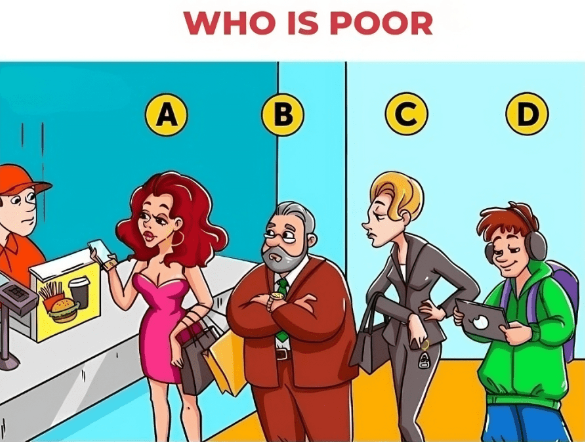In a world captivated by online riddles and visual challenges, the question “Who is poor
In a world captivated by online riddles and visual challenges, the question “Who is poor?” has become a popular puzzle. This particular brainteaser presents an image of four individuals, each with distinct appearances and accessories. It challenges observers to determine which person might be the least financially secure based solely on subtle visual cues. So, who among these four stands out as the answer? Let’s dive into each character’s appearance and analyze the clues.
Setting the Scene: Observing the Four Individuals

The image features four people—labeled as Person A, B, C, and D—all waiting in line, each with a unique style that hints at their financial standing. By carefully examining their clothing, accessories, and body language, we can gather clues about their lifestyles and socioeconomic status.
Character Analysis: Decoding Each Person’s Visual Cues
Person A: The Fashionable Woman in Pink
Person A stands out with her bold, stylish attire, complete with matching accessories that suggest an appreciation for luxury.
- Appearance: She wears a chic pink outfit, accessorized with jewelry and a designer handbag.
- Accessories: She holds shopping bags and a smartphone, items often associated with modern, urban affluence.
- Impression: Her polished look and shopping bags indicate disposable income and a tendency toward luxury, which isn’t commonly associated with financial hardship.
Given her fashion-forward appearance, Person A is unlikely to be the “poor” person in this scenario. Her choice of accessories and confident demeanor suggest financial comfort.
Person B: The Elderly Gentleman in a Suit
Person B exudes an air of refinement and stability with his formal attire and composed demeanor.
- Appearance: Wearing a suit and tie, he appears well-groomed, which aligns with a professional or retired lifestyle.
- Impression: The suit suggests familiarity with professional settings, possibly hinting at a career or background that afforded him financial security.
- Lifestyle Implication: His attire implies he has likely maintained a stable lifestyle, not indicative of someone experiencing financial difficulty.
Person B’s polished appearance and age suggest he might be financially secure, perhaps enjoying the fruits of a long career. Thus, he doesn’t fit the profile of someone in poverty.
Person C: The Professional Woman in Business Attire
Person C is dressed in business attire, exuding confidence and professionalism.
- Appearance: Dressed in a business suit and holding a formal handbag, she looks poised and ready for a corporate setting.
- Body Language: Her confident stance indicates familiarity with an office environment, hinting at a stable position or career.
- Impression: Her business-like appearance suggests she has financial stability due to a regular income.
Person C’s professional look and demeanor make her unlikely to be poor. She appears financially secure and is likely accustomed to a steady, dependable lifestyle.
Person D: The Casual Young Man with Gadgets
Person D stands out due to his relaxed, casual attire and functional accessories.
- Appearance: Dressed in a hoodie and jeans, his casual style contrasts with the formal attire of the others.
- Accessories: Equipped with headphones, a tablet, and a backpack, he has a student-like appearance that implies a limited budget.
- Impression: His gadgets are practical rather than luxurious, suggesting he may be living modestly on a restricted budget.
Unlike the others, Person D’s simple, functional attire and student-like belongings hint at a more modest lifestyle. This practical appearance suggests he could be facing financial limitations.

Why Person D is Most Likely to Be “Poor”
After a thorough analysis of each individual, several factors point to Person D as the one most likely experiencing financial limitations:
- Casual Attire: Person D’s hoodie and jeans lack the sophistication or luxury associated with affluence, suggesting a simpler, more modest lifestyle.
- Student-Like Appearance: The backpack and tablet hint at a student status, a group commonly associated with limited financial resources and reliance on modest means.
- Functional Accessories: While he has modern gadgets, they appear to serve practical rather than status purposes, contrasting with the other characters who display signs of affluence.
- Absence of Wealth Indicators: Unlike the other characters, Person D lacks luxury items or expensive clothing. He doesn’t show any signs of affluence, making him stand out as the most likely answer.
The Importance of Observation: Spotting Subtle Clues
This puzzle challenges us to look beyond surface assumptions and focus on the subtleties. While flashy items like Person A’s shopping bags or Person B’s suit may capture initial attention, careful observation reveals that the answer lies in noticing the practical nature of Person D’s belongings and his overall casual appearance. Through close observation, we learn that visual cues such as clothing and accessories can reveal deeper socioeconomic indicators.
Breaking Down Assumptions: Why Appearances Can Be Deceptive
Visual puzzles like this remind us that appearances are often deceiving. It’s easy to associate luxury items with wealth and simpler clothing with financial struggle, but these stereotypes aren’t always accurate. This puzzle encourages us to look beyond assumptions, training our brains to examine each detail before drawing conclusions.
Conclusion: Person D is the Answer
After examining each character, it becomes clear that Person D is the most likely answer to “Who is poor?” His casual style, lack of luxury items, and student-like appearance point to a more modest lifestyle than that of the other individuals. This riddle not only provides an entertaining challenge but also serves as a reminder of the importance of careful observation and critical thinking in analyzing the world around us. Did you spot the correct answer? If so, congratulations on your keen eye for detail!






